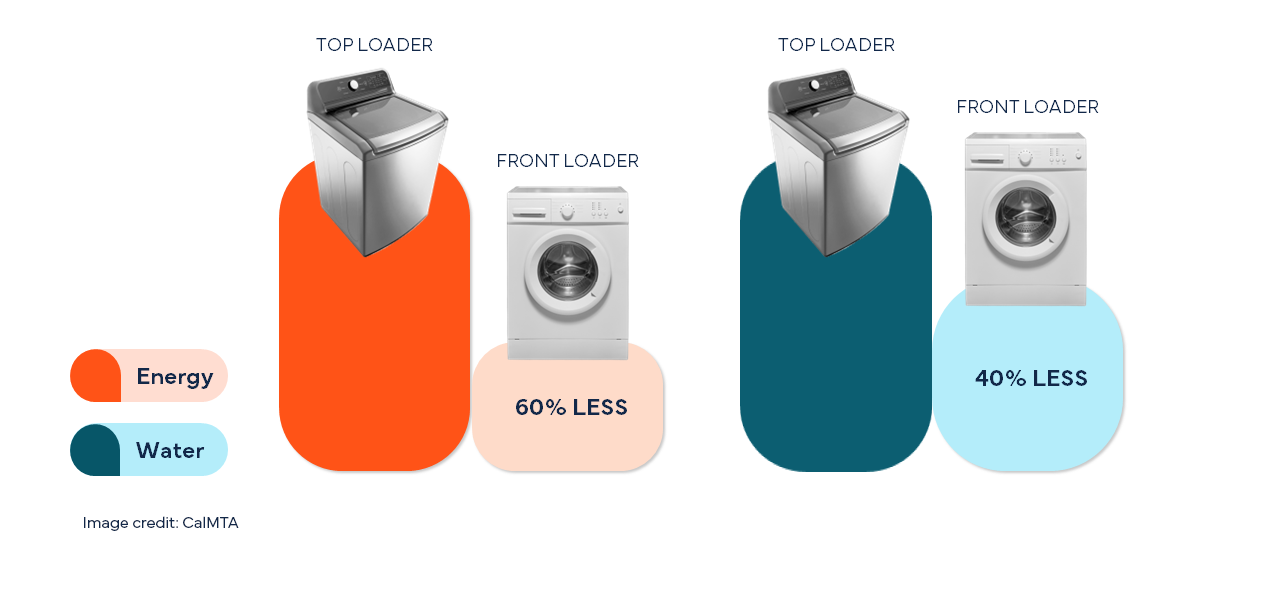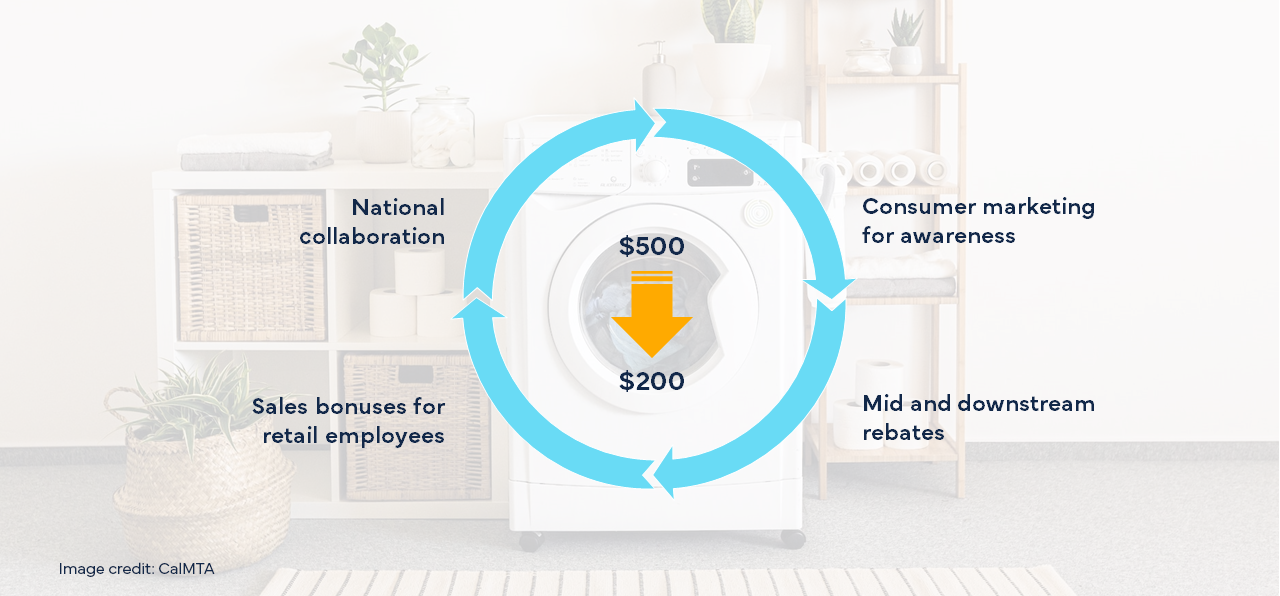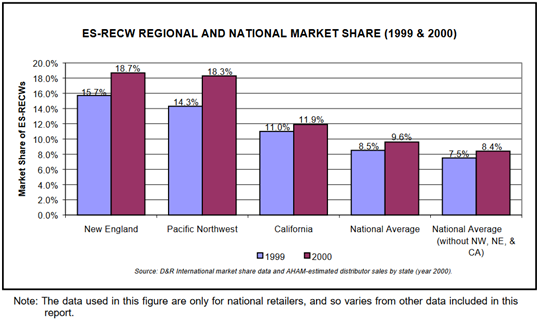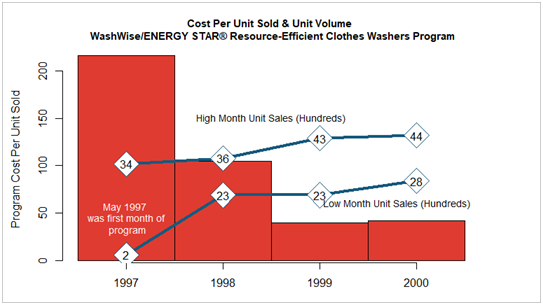
Case study: front-loading clothes washers
Between 1993 and 2000 market transformation efforts drove an increase from 2% to 10% in the market share of front-loading clothes washers and set the stage for further growth that reached 38% by 2005 and 55% by 2019.
Background
The household clothes washer market in the United States was dominated in the early 1990s by top-loading machines with a market share of approximately 98%. At the same time, front-loading washers were becoming popular in Europe, and for good reason. Front-loaders generally use about 60% less electricity and 40% less water. This situation made clear that there were big opportunities for this product in the areas of energy efficiency and water conservation.
 These opportunities helped motivate diverse market actors and regulatory groups. For utilities, solving this problem could give them a big boost toward achieving their efficiency goals. For regulators this was an opportunity to make a larger than usual impact with changes in their guidelines. For manufacturers and retailers this presented a large sales potential. Finally, for end users, there were opportunities in some instances for purchase incentives and for all users, long-term savings in energy and water costs.
These opportunities helped motivate diverse market actors and regulatory groups. For utilities, solving this problem could give them a big boost toward achieving their efficiency goals. For regulators this was an opportunity to make a larger than usual impact with changes in their guidelines. For manufacturers and retailers this presented a large sales potential. Finally, for end users, there were opportunities in some instances for purchase incentives and for all users, long-term savings in energy and water costs.
The Market Transformation process in action
Prior to the introduction of active, coordinated Market Transformation (MT) efforts, there was an existing product, the Neptune front-loader by Maytag. In 1992, Maytag worked with the Electric Power Research Institute (EPRI) to develop this product for energy and water savings. These were popular among early adopters to the point that they often had to join waiting lists to get one.
MT activity began in earnest in 1993 when the Consortium for Energy Efficiency (CEE) began collaborating with a group of utilities in the Western United States to develop energy efficiency specifications for utility programs. To implement these programs the utilities required relevant performance and market data to guide them. To supply the needed data a joint effort between the U.S. Department of Energy (DOE), the city of Seattle, several western utilities, and EPRI developed The High Efficiency Laundry Metering & Marketing Analysis (THELMA). THELMA research found that the market had potential for transformation, but that four key barriers had to be overcome for utility programs to be successful:
- high initial cost,
- lack of consumer familiarity,
- limited availability of front-loading products and limited knowledge about products by retailers, and
- a lack of front-loading washers that met consumer design preferences.
In 1994, DOE created a strong call to action by introducing a modest new minimum efficiency standard for clothes washers generally. Shortly thereafter they started work on even higher standards. The new standards used the efficiency advantages of front-loader technology as their basis. Because front-loaders were better able to meet these standards, manufacturers now had an incentive to expand their front-loader product offerings.
1997 saw the implementation of a full-blown MT plan organized by the Northwest Energy Efficiency Alliance (NEEA). This program was originally named WashWise and later renamed ENERGY STAR Resource-Efficient Clothes Washer Program and ran until 2001. The program addressed some of the key barriers identified by THELMA.
Breaking down barriers
A lack of consumer awareness of the product was one major challenge that WashWise faced. To overcome this a strategy involving various elements was put in place. As one part of the strategy traditional advertising campaigns by the program team, retailers, and manufacturers were implemented.
Another approach to educating consumers was through direct promotion during their visits to retailers. Store employees were trained to discuss the benefits of the product such as long-term savings on electricity and water bills. These person-to-person interactions enabled the stronger impressions that such conversations foster. To encourage the employees to engage with customers they were given small bonuses (usually $10) for each sale made.
Finally promotional events were held. These included sweepstakes and demonstration types of events (one notable case was the “Grimiest Soccer Team” promotion with U.S. women’s Olympic soccer player Brandi Chastain as a spokesperson).
To address high prices, the initial program under WashWise provided for a $130 rebate to the customer at the point of sale and a $20 rebate to the retailer. In 1998, the rebates were discontinued but sales did not decline and in fact continued to increase (see figure 2 below).
The constraint of limited selection was also addressed. During the MT program period, more manufacturers and models appeared in the energy-efficient clothes washer market (there were two qualifying models available in 1995 and by 2000 there were 62) helping to provide increased choices and supply.
The combined effects of the MT activities and increasing availability helped to eventually reduce the cost premium of an ENERGY STAR washer over a standard top-loader from over $500 to around $200.

The steps highlighted above point out several key elements of MT.
1) MT is not an activity undertaken by a single market player, but rather a collaboration.
2) The primary goal of MT is to remove barriers to adoption. In this case, a preferred product existed but consumers were unaware of it, it had limited availability, and was expensive. For these reasons, the product was unappealing to manufacturers who didn’t see a profit opportunity.
Market barriers for good products are often overcome through the passage of time with standard business practices, but active intervention can accelerate the process significantly. For important problems such as the need to increase energy efficiency and reduce greenhouse gases, an active approach to accelerate product adoption is a critical tool.
Front-loader market transformation success indicators
Figure 1 shows indicators of market share growth where MT programs were in effect for front-loaders in the Pacific Northwest (WashWise/ENERGY STAR Resource-Efficient Clothes Washer Program) and in New England with a program run by Northeast Energy Efficiency Partnerships (NEEP).

Figure 1: Source (NEEA Market Progress Evaluation Report ENERGY STAR Resource-Efficient Clothes Washers, No. 5)
Figure 2 shows evidence of success for one of MT’s main goals, lasting transformation. Ideally after time, sales stimulated in an MT program will sustain themselves and continue to grow even as the active program is wound down or exited. In this case, in the absence of increased funding the low and high sales volume months each year show that upward sales trends are sustained even in the face of normal market characteristics such as seasonality.

Figure 2: Source (NEEA Market Progress Evaluation Report ENERGY STAR Resource-Efficient Clothes Washers, No. 5). Figure 2 combines data from to separate plots in NEEA report
Summary of barriers and measures used to overcome them
- Consumer awareness: Active promotion through marketing support for retailers, events, and publicity such as positive reviews in Consumer Reports magazine.
- Pricing barriers: Incentive programs for consumers and retailers. Long-term savings for consumers through reduced electricity and water costs.
- Lack of Supply: Manufacturers were incented to enter the market to capture market opportunities.
- Competition with top loaders: Standard setting by the DOE and other bodies signaled to manufacturers that the efficiency and water savings benefits of the front loaders were preferred. This also spurred higher efficiency designs for top loading machines.
Sources
- U.S. And International Experience With Market Transformation; The American Council for an Energy-Efficient Economy (ACEEE)
- NEEA Market Progress Evaluation Report ENERGY STAR Resource-Efficient Clothes Washers, No. 5
- Spinning Toward High-Efficiency Clothes Washers; Andrew deLaski, Consortium for Energy Efficiency; Ted Pope, Seattle City Light
- Grand View Research – Smart Washing Machine Market Size, Share & Trends Analysis Report By Product (Front Load, Top Load)
- ENERGY STAR Resource-Efficiency Clothes Washers Market Progress Evaluation Report #4 Final Report
Subscribe
Want to learn more? Sign up for our mailing list to be notified of upcoming events, including Advisory Board meetings, informational webinars, important RFI deadlines, and more.